
This development could foreshadow significant changes to the renewable energy market in the upcoming years. Wind technology is progressing rapidly, and policy efforts in the United States to potentially decarbonize the energy market may create an opportunity for wind as the poster child of greener electricity.
The latest market predictions hold that renewable energy will account for half of our global electricity supply by 2035. Over the past few years, the impact of green power has been subject to speculation.
Some studies show that renewables will transform the energy industry substantially, while others hypothesize on the future of natural gas in a post-carbon economy. With wind emerging as the top renewable source of electricity in the United States, the capacity for the market to become greener is greater than ever.
Technological advancements play a central role in innovating how wind power is generated and stored. The ability to utilize real-time testing software in the analysis of renewable energy potential will be crucial to the market's growth.
The global market for wind energy is forecasted to nearly double between 2019 and 2026. These statistics are highly dependent on recent advances in energy-storing capabilities.
One of the main challenges that wind energy presents is the issue of reliable power generation. Not only is it subject to daily fluctuations based on the weather, but it also is more prevalent in some parts of the country than others.
One of the leading innovators in the industry is Siemens Gamesa Renewable. The company began working on a transformative technology to store wind energy in 2010.
Known as Electric Thermal Energy Storage, the system makes it possible to store surplus energy. Because the storage method can use traditional industrial chambers, ETES technology has the potential to transform old coal plants into energy storage hubs.
The latest projection has renewable energy surpassing natural gas by 2050.
Shale oil and gas signaled a pivotal moment in the last decade. The resource was touted as a more sustainable alternative to oil, while not quite being qualifiable as a renewable source of energy.
However, the major challenge of the energy industry moving forward is climate. Natural gas production was originally understood as a clean alternative to coal. With the emergence of an economically viable renewable option, the exodus from fossil fuel reliance may occur sooner than we think.
While the likelihood of wind energy surpassing fossil fuel production in the next decade is improbable, recent policy changes mark a distinct shift. Decarbonization efforts are well underway. Wind energy is emerging as a multibillion-dollar industry. States on the East and West coasts hold the greatest potential since they are moving most notably away from gas, though it still is set to increase in Southern and Midwestern states.
Efforts to reduce carbon emissions will most likely become a political issue as much as economics, with the American Energy Innovation Act currently moving through the U.S. Senate. The bill proposes an increase in clean energy investments, though its impact on wind energy, in particular, is hard to say.
Investments in wind technology continue to transform the power of this energy source. Wind turbines are present in every state in the country, and the majority have only been installed in the last 10 years. With new solutions to challenges like storage, wind may transform the U.S energy sector in unforeseen ways.
Decisions within the energy sector will set the groundwork for wind potential in the next decade. With renewable energy becoming cost-competitive with fossil fuel production, power generated from fossil fuel alternatives is likely. Whether wind continues as the renewable powerhouse for electricity generation remains to be seen.
Emily Folk grew up in a small town in Pennsylvania. She has a passion for ecology and conservation and sustainability.
In high school, she discovered her other passion: writing. After graduating with a degree in Professional Writing, the most natural step seemed to be combining the two passions in one forum. Her goal is to help people become more informed about the world and how we fit into it.
Her website is Conservation Folks

